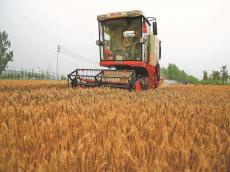|
|
TODAY.AZ / Business
From war zones to wheat fields: quiet revolution in Azerbaijan
04 May 2025 [20:15] - TODAY.AZ
 By Nazrin Abdul
By Nazrin AbdulBy any measure, the reclamation of over 100,000 hectares of agricultural land in Azerbaijan’s formerly occupied territories is a remarkable achievement. In just a few years since regaining control over these regions, Azerbaijan has not only restored vast stretches of arable land but also planted the seeds—both literal and symbolic—of a more resilient, self-sustaining national economy.
This transformation is not just about crop yields or economic gain. It is about restoring dignity, healing wounds, and asserting a sovereign future built on the very soil that had, for decades, been marked by conflict and neglect.
In a world grappling with food insecurity, disrupted supply chains, and climate volatility, Azerbaijan’s quiet agricultural renaissance deserves international attention. The country’s success in rehabilitating more than 100,000 hectares of farmland, with an additional 100,000 hectares nearly ready to be brought into rotation, is not just a technical achievement—it is a political and social milestone. It speaks to the vision of a leadership that has placed rural revitalization and food security at the heart of post-conflict recovery.
This renewed focus on agriculture is no accident. It reflects a deliberate strategy by Azerbaijan’s government to reintegrate the liberated territories into the national fabric, not merely through infrastructure projects and housing, but through the lifeblood of the land: farming. In doing so, the state is asserting something essential—that prosperity and peace must grow from the ground up.
Consider what reclaiming land really means in this context. For decades, much of this territory lay abandoned, riddled with landmines, deprived of basic infrastructure, and unable to support even subsistence agriculture. Now, fields that were once no-go zones are sprouting wheat, barley, and other essential crops. This is not just economic development; it is a form of renewal—a way to make the land live again and to provide livelihoods for thousands who were displaced or cut off from opportunity.
To call this progress “an agricultural success” would be an understatement. It is the visible outcome of state planning, investment, and an unwavering focus on rebuilding. It is also a direct result of the political will of Azerbaijan’s leadership to prioritize rural development not as an afterthought, but as a core national mission.
Of course, challenges remain. Restoring soil quality, upgrading irrigation systems, and ensuring sustainable farming practices are not tasks that end with plowing a field. There is still a long road ahead to modernize supply chains, integrate these regions into broader economic flows, and attract young people to careers in agriculture. But with the foundation now firmly in place, the path forward looks promising.
There is also a broader message here—one that extends beyond Azerbaijan’s borders. As the world rethinks food security in an era of climate stress and geopolitical instability, the Azerbaijani model of reclaiming and revitalizing post-conflict agricultural land offers an instructive case study. It demonstrates that recovery is possible when vision aligns with action and when political commitment is matched by technical execution.
The story of Azerbaijan’s agricultural revival in its liberated lands is not just one of reclaimed fields. It is a testament to national resilience, strategic foresight, and the enduring value of land not just as territory, but as promise
URL: http://www.today.az/news/business/258870.html
 Print version
Print version
Connect with us. Get latest news and updates.
See Also
- 10 December 2025 [12:42]
Experts highlight innovation barriers and opportunities in Next-Generation Oil and Gas Coating Technologies - 10 December 2025 [12:03]
Upcoming Türkiye-Azerbaijan business forum to convene in Baku - 09 December 2025 [11:35]
Maintaining infrastructure critical for energy future, says SOCAR deputy VP - 08 December 2025 [18:39]
Azerbaijan advances digital platform for customs guarantees and insurance - 08 December 2025 [15:15]
Creative industries contribute three per cent to global GDP, Minister says - 08 December 2025 [14:54]
Georgia allows one-time free transit of Azerbaijani oil products to Armenia - 08 December 2025 [12:29]
Construction of Shafag Solar Power Plant progressing successfully, bp says - 08 December 2025 [10:43]
Azerbaijan strengthens economic diversification and trade facilitation through new customs reforms - 05 December 2025 [13:58]
Southern Gas Corridor to channel most earnings to SOCAR and Azerbaijani state - Fitch says - 05 December 2025 [11:23]
Fitch Ratings assigns “BBB-” long-term IDR with stable outlook to Southern Gas Corridor
Most Popular
 Important project for Baku receive approval of EU: East-West energy chain close
Important project for Baku receive approval of EU: East-West energy chain close
 Minorities Rights Bill 2025 passed: Pakistan creates autonomous watchdog for religious minorities
Minorities Rights Bill 2025 passed: Pakistan creates autonomous watchdog for religious minorities
 Parallel worlds of European Union and South Caucasus
Parallel worlds of European Union and South Caucasus
 Georgia allows one-time free transit of Azerbaijani oil products to Armenia
Georgia allows one-time free transit of Azerbaijani oil products to Armenia
 President Ilham Aliyev receives CEO of Global Infrastructure Partners
President Ilham Aliyev receives CEO of Global Infrastructure Partners
 Speaker Gafarova highlights Parliament’s role in shaping future of Azerbaijani language
Speaker Gafarova highlights Parliament’s role in shaping future of Azerbaijani language
 OIC Cultural Festival commences in Baku
OIC Cultural Festival commences in Baku
